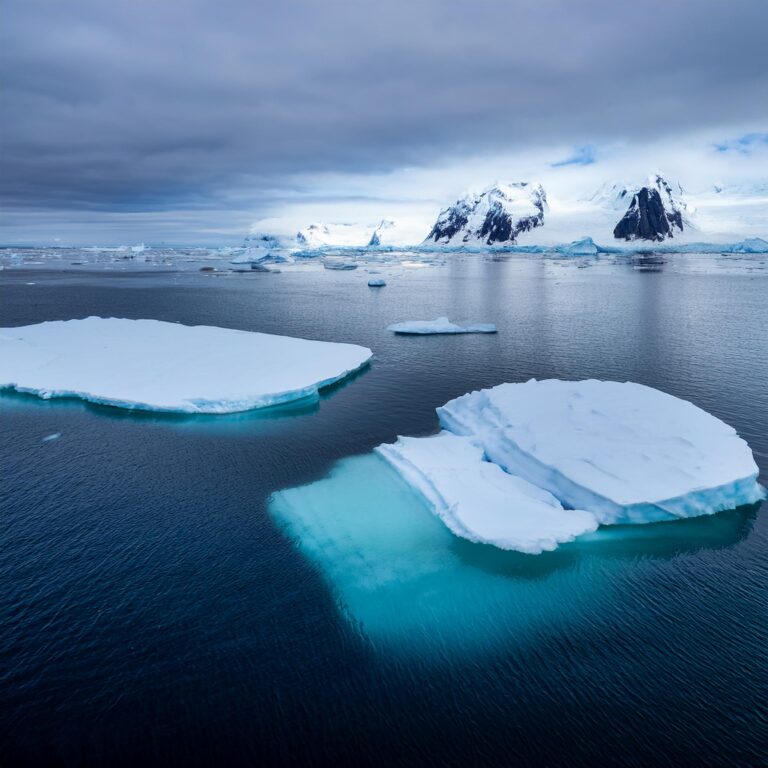One of the most fascinating phenomena of nature is drifting ice sheets. The massive ice formations that are often found in the polar regions not only attract attention but also have a significant impact on our planet’s ecosystem and climate. This article will examine the science of drifting sheets, the significance of these giant icebergs in nature, and their impact on climate change.
Topics covered:
- The Formation of Ice Sheets and Their Types
- The role of ice sheets in ecosystems
- Climate Change: The Effects
- Future Projections and adaptation strategies
Understanding Ice Sheets
What Are Ice Sheets?
The vast sheets of ice cover immense land areas, usually in polar regions. These ice sheets are essential for understanding Earth’s climate and as significant freshwater reservoirs. The two most extensive ice sheets in the world are found on Earth, and they contain 68% of all freshwater.
Form and composition
Snowfall is the first step in forming ice sheets. As the snow layers accumulate each winter, they compress under their weight. This process will continue until the snow becomes firm, a granular ice type.
Lifecycle of an Ice Sheet
- Snowfall: New snow accumulates during winter.
- Compression: As layers are compressed, snow becomes firm.
- Glacial Ice Formation: As firn is compressed and cooled, it becomes glacial ice.
Different types of ice sheets
There are two main types of ice sheets:
- Continental Ice Sheets: This is a massive sheet that covers large areas. Examples include the Antarctic and Greenland Ice Sheets.
- The Ice Caps are smaller than continental ice sheets and cover less than 50 square kilometres. They can be found mainly in the polar and subpolar areas.
Icebergs and Drifting Ice Sheets
You must distinguish between drifting sheets of ice and icebergs. On the other hand, icebergs are pieces of ice that break from a glacier or an ice shelf and drift in the water.
What are the Dynamics of the Ice Movement?
Gravity and melting are the main factors that cause ice sheets to move. Icebergs can be formed when ice flowing downhill creates crevasses or significant rifts. You can learn more about ice sheets and their environmental impact by visiting the National Snow and Ice Data Center or the NASA Ice Sheet Program to discover the most recent advances in ice sheet research.
What is the role of drifting ice sheets in ecosystems?
Climate Regulation
The climate of the Earth is regulated by drifting sheets of ice. Reflecting sunlight helps maintain the temperature balance and cools down planet Earth. The albedo is vital for maintaining global temperatures.
Albedo Effect
Albedo is the term used to describe the Earth’s reflectivity. The albedo of ice is high, which means it reflects solar energy into the space. The melting of ice sheets exposes darker surfaces on the ocean and land, which absorb more heat, thus accelerating global warming.
Habitat for Wildlife
The ice sheets, as well as their surroundings, provide habitats that are vital for many species. These include seals, bears and migrating birds. They are a unique adaptation to harsh conditions and essential for biodiversity.
Notable Species
- Polar Bears: Polar bears depend on the sea ice to hunt seals.
- Seals Use ice to breed and rest.
- Birds: Many bird species nest in ice-covered areas.
Visit our article Biodiversity and its Importance to understand this ecosystem better.
Ocean Currents: Influence
Ocean currents can be affected by the melting of ice and its drift. Fresh water entering the ocean due to melting ice alters its salinity, which affects global circulation patterns. The climate can be affected by these changes.
Ocean Circulation, Climate and Climate
Freshwater emitted by melting ice can disrupt the global conveyor belt that regulates climate. This can cause changes in weather patterns and the distribution of temperatures worldwide. Check out this guide, Understanding Ocean Currents, to learn more.
Climate Change: Its Impact
Melting Ice Sheets
Climate change is a major factor in drifting ice sheets—global temperatures cause ice to melt faster, contributing to rising sea levels. The phenomenon is a danger to communities along the coast and their ecosystems.
The melting rate
Greenland melts 280 billion tonnes of ice annually, according to recent studies. The rapid melting of ice in Greenland contributes to the rising sea level, which has already risen by 3 inches since 1993.
Feedback Loops
Melting ice sheets can create a negative feedback loop, exacerbating climate change. The melting of ice sheets causes less light to be reflected. This leads to a warmer ocean temperature and further melting. The global climate system is affected by this cycle.
Feedback Loops: Consequences
- Higher Temperatures As the reflective surfaces are removed, heat is more readily absorbed. This increases local temperatures and global temperatures.
- Increased Ice Sheet Loss Warmer temperatures cause more melting and further instability of ice sheets.
Monitoring and research
Satellite technology and observations on the ground are used by scientists to continuously monitor ice sheets. Researchers are attempting to determine how the melting rate affects sea levels and climate patterns.
Key Research Initiatives
- NASA IceBridge Program: Measures the ice sheets’ thickness and surface elevation.
- CryoSat of the European Space Agency: monitors changes in thickness and volume.
You can also read our articles on Understanding Climate Change and IPCC reports on Climate Change to gain more insight into the subject.
Future of Drifting Ice Sheets
Predictions, Projections
Modelling studies predict that large portions of Greenland’s and Antarctica’s ice sheets will melt if the current trend continues. This would contribute to a sea-level rise of several feet in the next few decades. The predictions highlight the urgency of climate action.
Key Projections
- Greenland’s Contribution Could contribute as much as 1.5 meters of global sea-level rise by 2100 if melting rates remain unchanged.
- Antarctic Vulnerability: The West Antarctic Ice Sheet could cause a catastrophic rise in sea levels.
Adaptation strategies
Communities all over the globe are implementing adaptation strategies to deal with the rising effects of sea levels. They include the construction of sea walls, improvements to drainage systems and sustainable urban planning.
Examples of Adaptation
- Coastal Resilience planning Cities such as Miami and New York invest in infrastructure to fight rising sea levels.
- Wetland Restoration: Restoring wetlands can be a natural barrier against flooding and storm surges.
Explore our article Sustainable Urban Planning Strategies for more information on urban adaptation strategies.
Global Cooperation: Its Importance
International collaboration is needed to address the melting of ice sheets. To reduce greenhouse gas emissions, countries must share data, develop technologies, and implement policies that protect fragile ecosystems.
Global Agreements and Initiatives
- Paris Agreement: An international treaty limiting global warming below 2 degrees Celsius.
- UN Sustainable Development Goals: Goals relating to climate change and sustainable environmental practices.
You can learn more about global climate agreements by visiting the United Nations Framework Convention on Climate Change.
The conclusion of the article is:
The ice sheets that drift across the earth’s surface are not just a beautiful natural phenomenon but also a vital role in our climate and ecosystem. Understanding and protecting these giant ice sheets becomes more important as we confront the realities of climate change. By raising awareness, we can ensure future generations continue to be amazed by the drifting ice sheets’ beauty and importance.



